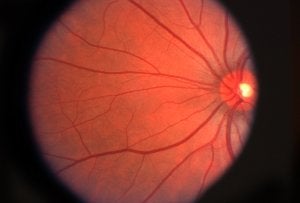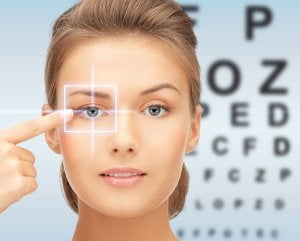-
Understanding Cataracts
A cataract is a cloudy area in the lens of the eye that makes it difficult to see. Cataracts can be caused by aging, sunlight exposure, and eye injuries. They can be diagnosed and treated by an eye doctor or ophthalmologist in Chicago . Treatment may include corrective lenses and/or surgery.
Watch this video to learn more about cataracts. An eye doctor with the National Eye Institute discusses the causes, symptoms, diagnosis, and treatment options for those with cataracts. Cataracts can cause a slow, gradual loss of vision, and some people are not afflicted with vision loss at all. If you suspect you may be suffering from cataracts, visit an eye doctor or ophthalmologist near you.
-
Spotlight on Macular Degeneration
 Macular degeneration is an eye condition that is caused by the retina deteriorating and vision becoming impaired. The condition can be diagnosed and treated by an eye doctor or ophthalmologist in Chicago . Symptoms include the distortion of lines or the center of vision, the appearance of dark, blurry areas in the center of vision, the white out of the center of vision, and diminished or distorted perception of color.
Macular degeneration is an eye condition that is caused by the retina deteriorating and vision becoming impaired. The condition can be diagnosed and treated by an eye doctor or ophthalmologist in Chicago . Symptoms include the distortion of lines or the center of vision, the appearance of dark, blurry areas in the center of vision, the white out of the center of vision, and diminished or distorted perception of color.If you experience any of these symptoms, see an eye doctor or ophthalmologist as soon as possible. There is no cure for the condition, but your eye doctor can offer several treatment options for macular degeneration. These include medication called anti-angiogenic drugs that are injected into the eyes, laser therapy or photodynamic laser therapy, and certain vitamins. Vitamins C, E, beta-carotene, zinc, and copper can sometimes decrease the risk of vision loss that is associated with macular degeneration.
If you’ve been diagnosed with macular degeneration, you can prevent the condition from getting worse by making some simple lifestyle choices. Eat a healthy diet that is rich in dark green, leafy vegetables. Eat fish, and other foods rich in omega-3 fatty acids, and limit your intake of saturated fats.
-
A Look at Amblyopia
 Amblyopia, also known as lazy eye, is an eye condition that develops during childhood. It can be diagnosed by an eye doctor or ophthalmologist. The condition can be corrected over time with an early diagnosis and your child’s commitment to your eye doctor’s recommended treatment method. If you’re worried that your child is developing amblyopia, visit an ophthalmologist near Chicago , and continue reading to learn about the condition’s symptoms and treatment options.
Amblyopia, also known as lazy eye, is an eye condition that develops during childhood. It can be diagnosed by an eye doctor or ophthalmologist. The condition can be corrected over time with an early diagnosis and your child’s commitment to your eye doctor’s recommended treatment method. If you’re worried that your child is developing amblyopia, visit an ophthalmologist near Chicago , and continue reading to learn about the condition’s symptoms and treatment options.What is Amblyopia?
Amblyopia is a condition in which one eye is much weaker than the other one. As a result, the brain will only interpret the images that are received by the stronger eye, and the vision in the weaker eye will become worse and worse. You child can develop this condition at birth or at any point up until around 7 years of age. The younger your child receives treatment for the condition, the more successful the treatment will be. Amblyopia can be caused by genetics, low birth weight, strabismus, cataracts, or by being more nearsighted or farsighted in one eye than the other.
What are the Symptoms and How is the Condition Diagnosed?
The symptoms of amblyopia include an eye that wanders or looks in a different direction than the other eye, tilting the head or squinting to improve vision, an upper eyelid that droops, or crying and complaining when one eye is covered up. The condition is diagnosed by an eye doctor or ophthalmologist via an eye exam. The exam will demonstrate that the vision in one eye is worse than the vision in the other. No child is too young for an eye exam, so if you’re concerned that your child has amblyopia, make an appointment with an eye doctor as soon as possible.
How is the Condition Treated?
You child’s vision can be corrected if he begins using the weaker eye instead of the stronger one. The weaker eye will become stronger over time, and the vision in that eye will begin to get better. Your child’s eye doctor may make him wear an eye patch over the stronger eye.
-
Ophthalmologist Top 15 Foods for Eye Health
It sounds counterintuitive to eat your way to better eye health, but the truth is that nutrients in some foods can prevent eye disease and vision loss. You’ve probably heard that of carrots and leafy greens boost eye health, but there are numerous other foods that help you keep your vision.
Unsurprisingly, snacking your way to eye health starts in the produce section. A good rule of thumb is to pick fruits and vegetables of vibrant and deep coloring, which indicates high nutritional content, especially of vitamin A, which is crucial to eye health. But nutrient-rich foods aren’t just in the produce section: fish, nuts, and eggs all provide essential nutrients that can prevent macular degeneration and cataracts.
Remember, it’s important to eat with your eyes in mind. Since a lot of eye diseases can be prevented, it’s never too late to start adding foods for eye health to your diet.
